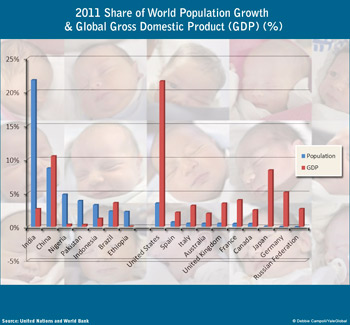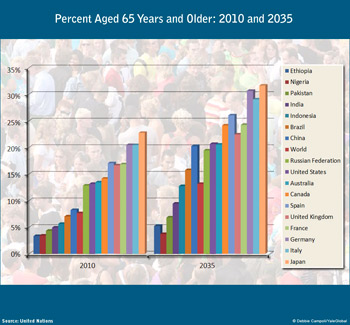For Better Planning, Watch Global Demographic Trends
For Better Planning, Watch Global Demographic Trends

NEW YORK: While governments and institutions try to grapple with economic uncertainty and volatility an important factor of relative certainty is often overlooked: demography. One may not know how the markets will behave, but demographic trends can provide instructive and relative certainty for the near term to deal with debt, taxes, unemployment and entitlements, to name a few. Dismissal of major demographic trends, seven of which described below, will in all likelihood result in ill-conceived policies, unsustainable programs and squandered resources.
First, at an estimated 7 billion, the world’s population is growing at 1.1 percent annually, or 78 million people, half the peak level of 2.1 percent in the late 1960s. Although the world’s demographic growth rate is continuing to slow due to declining birthrates, the 8 billion world population mark will likely be reached by 2025. This growth will increase the world’s working age population, 15 to 64 years, by 610 million and those aged 65 years and older by 290 million, increases of 13 and 52 percent, respectively.
Second, nearly all of the world’s annual demographic growth – close to 95 percent – is occurring in less developed regions. Top seven contributing nations are India, 22 percent; China, 9 percent; Nigeria, 5 percent; Pakistan, 4 percent; Indonesia, 3 percent; Brazil, 2 percent; and Ethiopia, 2 percent (see Figure 1). Due to its much higher growth, the juggernaut population of India – currently larger than all the developed regions combined – is expected to overtake China in a decade, when the Indian population is projected to reach 1.4 billion. Among more developed regions, the nation contributing most to world population growth is the United States at 3 percent, and the growth of the next six nations, including Spain, Italy, Australia, the United Kingdom, France and Canada, ranges from 0.7 to 0.5 percent.
Though nearly all of the world’s demographic growth is occurring in less developed regions, 54 percent of the world’s GDP is carried out by the 10 largest national economies of the more developed countries (Figure 1). Collectively, these more developed countries – led by the United States, Japan and Germany – represent 14 percent of world population, expected to decline to 11 percent by midcentury.
Third, in addition to global population growth largely taking place in less developed regions, populations are also becoming more concentrated in urban centers. Until recently, the majority of world population lived in rural areas, 61 percent, for example, in 1980. Today the proportion of people residing in urban centers is 52 percent, a figure expected to reach 60 percent by 2030.
Many of these urban centers are situated close to coastlines. Roughly a quarter billion people worldwide live along coastlines less than 5 meters above sea level. Climate change is making these urban centers more vulnerable to rises in sea-levels and other hazards such as storm surges and flooding. Countries such as Bangladesh, Vietnam and low-lying archipelagos of the Bahamas and Maldives and cities such as New York, New Orleans, Miami, Alexandria, Shanghai, Guangzhou, Kolkata, Mumbai and Osaka-Kobe are among the vulnerable areas.
Fourth, global fertility continues to decline. Today the average number of children per woman globally is 2.5 or about half the level 50 years ago. This downward trend is expected to continue, reaching 2.3 by 2025 and near replacement level of 2.1 children per woman by midcentury.
Behind such averages lie considerable demographic variations across regions. Fertility rates for most developed countries and increasing numbers of developing countries are at or below replacement, which translates into little or even negative rates of population growth. By midcentury, the populations of some three dozen countries, including China, Germany, Italy, Japan, South Korea, Poland and Russian Federation are expected to be smaller than they are today.
In contrast, African birthrates, having declined from averages of nearly 7 children per women, stand at more than 4 children per woman, with some countries, such as Mali, Niger and Uganda, continuing to have rates above 6 children per woman. Such fertility rates, though expected to decline, translate into rapid population growth for most sub-Saharan African countries for the coming decades. For example, with a current fertility rate of 5.5 children per woman projected to decline to 3.5 children per woman by 2050, Nigeria’s population of 162 million more than doubles to 390 million over the next 40 years. Similar patterns of population doubling, in some cases population tripling, are foreseen for many African countries, including the Democratic Republic of Congo, Niger, Mali and Uganda.
Fifth, a major consequence of declining birthrates, as well as increasing life expectancies, is population aging, a global transition to increasing proportions in the older age groups. The more developed countries are leading the way in this historic demographic shift. Some countries such as Germany, Italy and Japan have 20 percent or more of their populations aged 65 years and older (Figure 2). Although the proportions of elderly are lower, the pace of population aging among less developed countries is more rapid; Brazil, China and Indonesia are expected to see elderly proportions double within 25 years.
Sixth, due to increasing longevity, the numbers of oldest people, those aged 80 years and older and the most in need of old-age assistance and health care – are growing comparatively rapidly. Over the next 25 years, the numbers of the oldest, of which nearly two-thirds are women, are expected to increase from 105 million to 246 million, reaching 3 percent of world population, or double today’s proportion.
Among developed countries, the proportions of oldest by 2035 will set record highs: 14 percent for Japan, near 10 percent for Germany and Italy. Also, in countries such as China, Indonesia and South Korea, the proportion aged 80 years and older are expected to triple over the next 25 years.
Population aging and increased longevity are of mounting significance for policymakers in both more developed and less developed countries. Population aging, in particular, raises serious concerns about the financial viability of pensions and healthcare systems for the elderly. With the number of workers declining relative to those in the retirement category and growing numbers surviving to advanced ages, especially women, nations will face unavoidable fiscal challenges requiring thorny and unpopular economic decisions.
Seventh, as a result of differences in population growth and age-structures as well as in living standards between the more and less developed countries, powerful push-pull factors continue to produce large streams of international migrants. On the one hand, relative declines in the labor force and increases in the retired elderly present many wealthier nations with a difficult choice of more immigrants or fewer and older citizens. On the other hand, the populations of many developing nations, including India, Nigeria, Pakistan and the Philippines, continue to grow rapidly with many of their young men and women seeking opportunities in the urban centers of wealthier countries.
The consequences of these major demographic changes affect every aspect of human society, including food, natural resources, economic well-being, security, revenue, politics, employment and healthcare. Neither political rhetoric nor wishful thinking can dispel the enormous impacts. On the contrary, sustained critical attention, informed decision making and essential economic and social reforms, too often in short supply, are required to adjust to major population trends.
Economic uncertainty should not provide a pretext to avoid dealing with the great, undeniable demographic trends underway globally. Against this backdrop the policies and actions by governments, businesses, civil society and individuals will determine human well-being in the coming decades.
Joseph Chamie, former director of the United Nations Population Division, recently stepped down as research director at the Center for Migration Studies.

